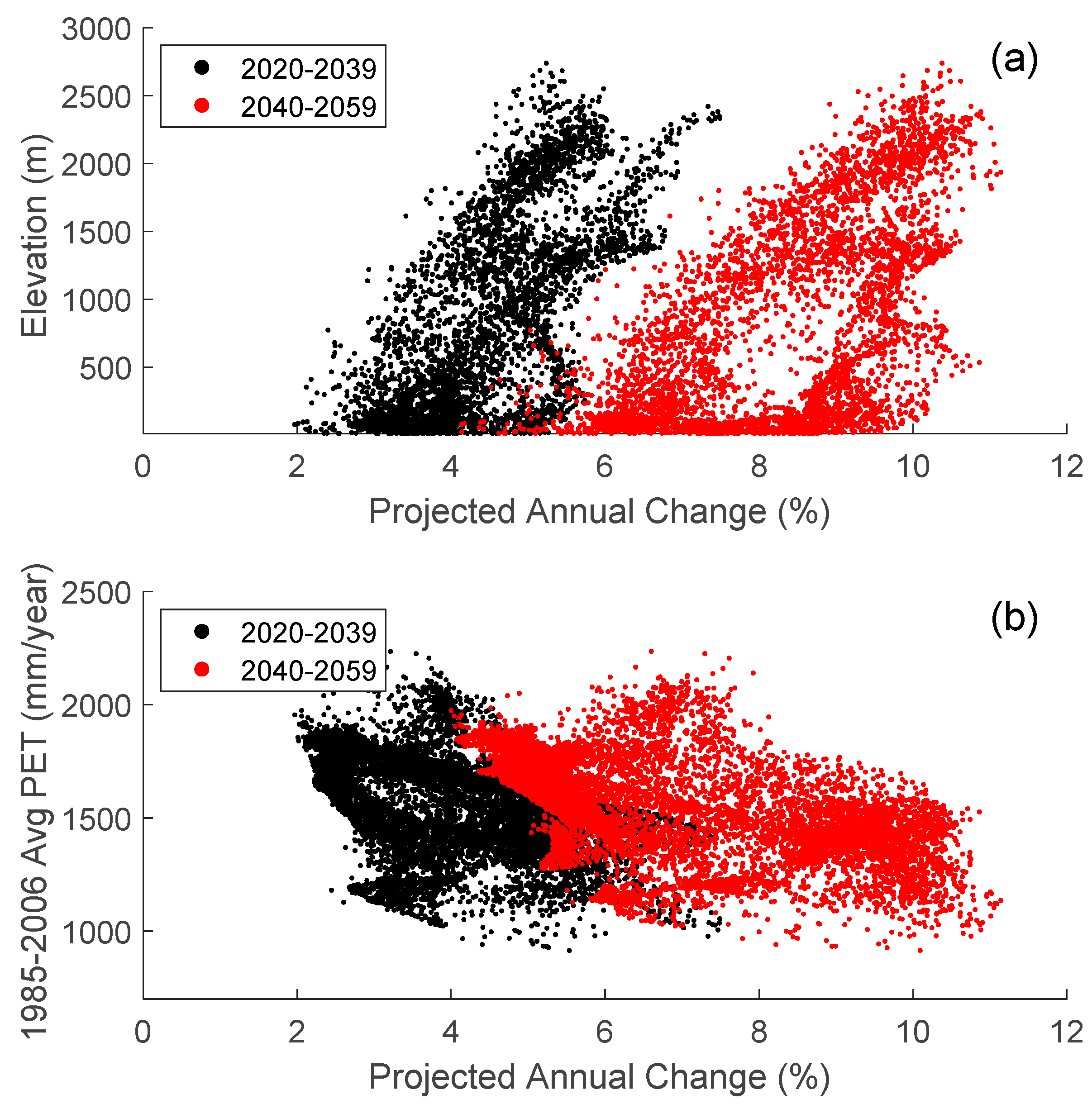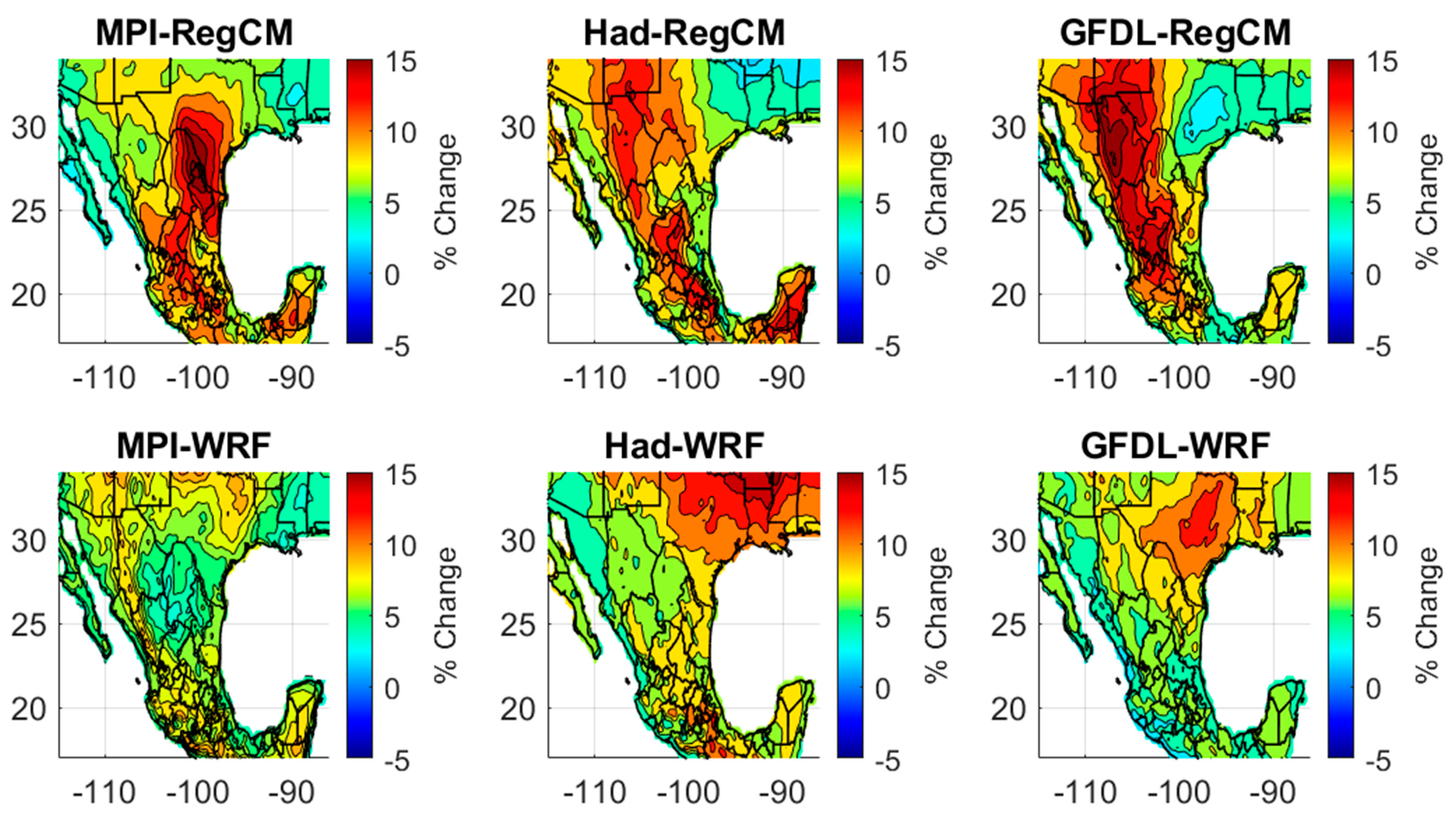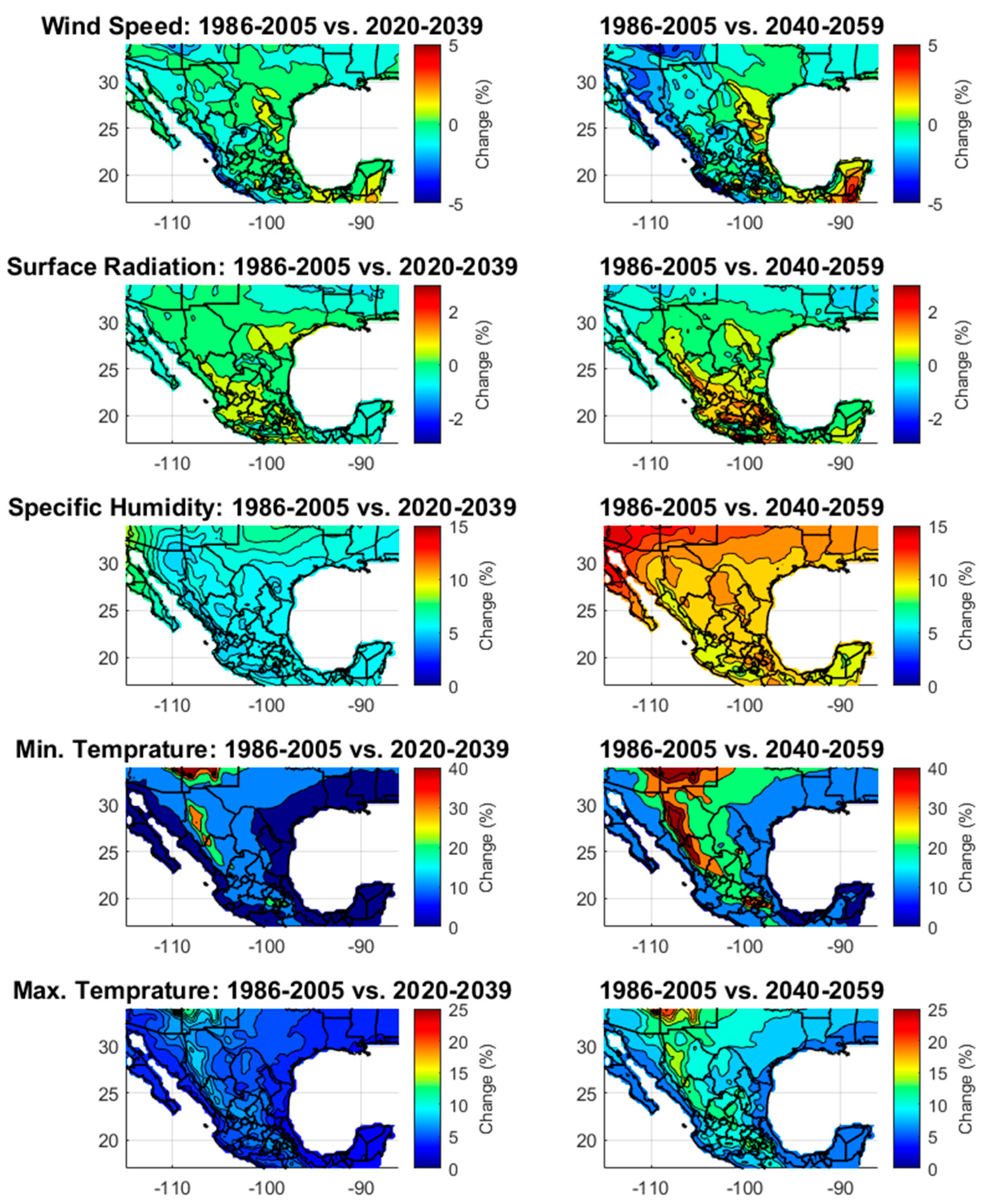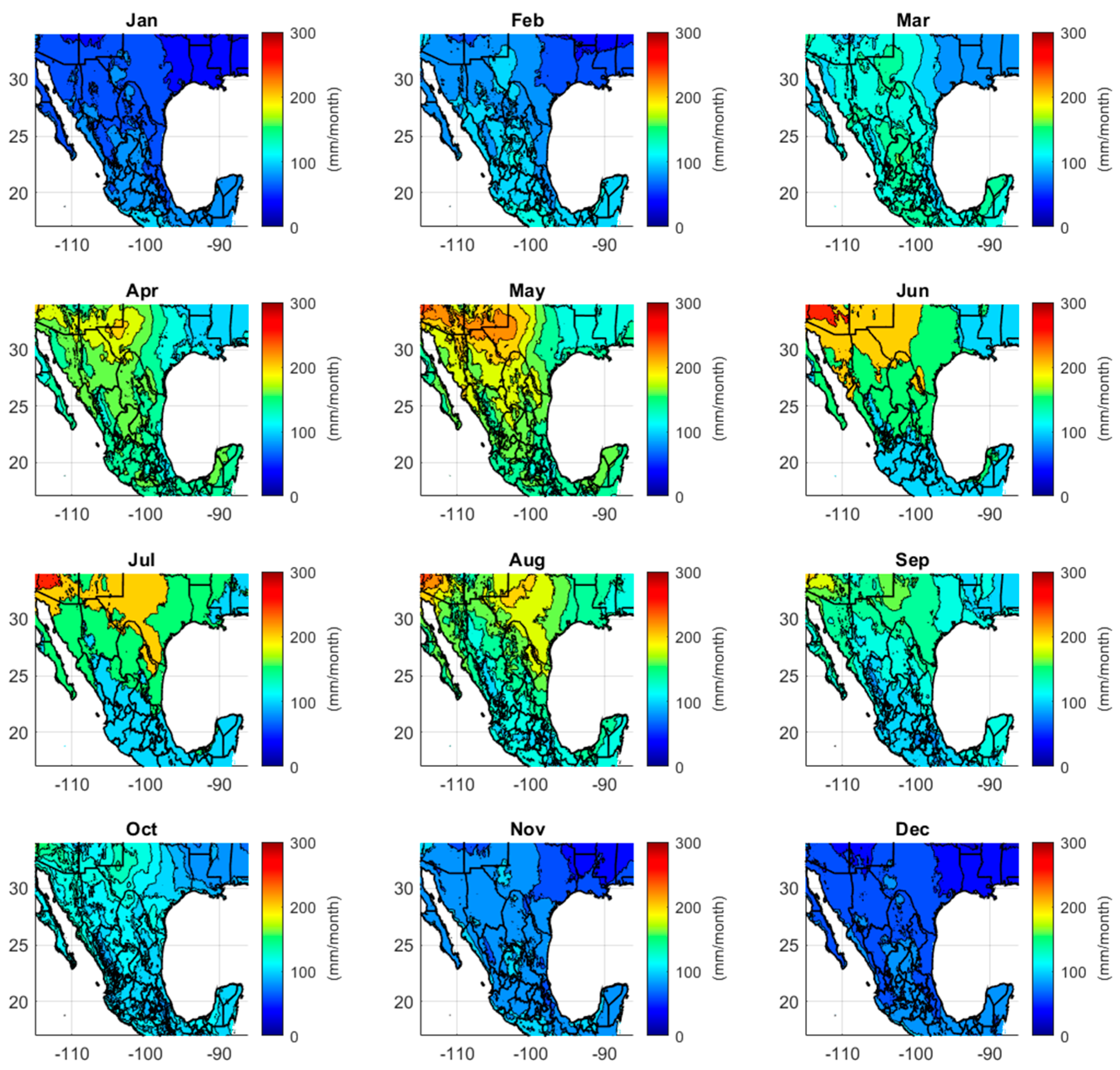Climate Change Projections of Potential Evapotranspiration for the North American Monsoon Region
Abstract
:1. Introduction
2. Materials and Methods
3. Results
3.1. Observed PET
3.2. PET Projections
3.3. Monthly PET Projections
4. Discussion
5. Conclusions
Author Contributions
Funding
Data Availability Statement
Acknowledgments
Conflicts of Interest
References
- Wang, B.; Biasutti, M.; Byrne, M.P.; Castro, C.; Chang, C.; Cook, K.; Fu, R.; Grimm, A.M.; Ha, K.; Hendon, H. Monsoon Climate Change Assessment. Bull. Am. Meteorol. Soc. 2021, 102, E1–E19. [Google Scholar] [CrossRef]
- Pascale, S.; Boos, W.R.; Bordoni, S.; Delworth, T.L.; Kapnick, S.B.; Murakami, H.; Vecchi, G.A.; Zhang, W. Weakening of the North American monsoon with global warming. Nat. Clim. Chang. 2017, 7, 806–812. [Google Scholar] [CrossRef]
- Pascale, S.; Carvalho, L.; Adams, D.; Castro, C.; Cavalcanti, I. Current and Future Variations of the Monsoons of the Americas in a Warming Climate. Curr. Clim. Chang. Rep. 2019, 5, 125–144. [Google Scholar] [CrossRef]
- Hernandez, M.; Chen, L. Future land precipitation changes over the North American Monsoon region usingCMIP5 and CMIP6 simulations. J. Geophys. Res. Atmos. 2022, 127, e2021JD035911. [Google Scholar] [CrossRef]
- Shamir, E.; Megdal, S.; Carrillo, C.; Castro, L.C.; Chang, H.-I.; Chief, K.; Corkhill, E.F.; Eden, S.; Georgakakos, P.K.; Nelson, M.K.; et al. Climate change and water resources management in the Upper Santa Cruz River, Arizona. J. Hydrol. 2015, 521, 18–33. [Google Scholar] [CrossRef]
- Shamir, E.; Tapia-Villaseñor, E.M.; Cruz-Ayala, M.-B.; Megdal, S.B. A Review of Climate Change Impacts on the USA-Mexico Transboundary Santa Cruz River Basin. Water 2021, 13, 1390. [Google Scholar] [CrossRef]
- Hu, H.; Dominguez, F. Evaluation of oceanic and terrestrial sources of moisture for the North American monsoon using numerical models and precipitation stable isotopes. J. Hydrometeorol. 2015, 16, 19–35. [Google Scholar] [CrossRef]
- Feng, X.; Houser, P. Quantifying the strength of land–atmosphere coupling in the 2004 North American monsoon. Atmos. Sci. Lett. 2015, 16, 391–397. [Google Scholar] [CrossRef]
- McVicar, T.R.; Roderick, M.L.; Donohue, R.J.; Li, L.T.; Van Niel, T.G.; Thomas, A.; Grieser, J.; Jhajharia, D.; Himri, Y.; Mahowald, N.M.; et al. Global review and synthesis of trends in observed terrestrial near-surface wind speeds: Implications for evaporation. J. Hydrol. 2012, 416–417, 182–205. [Google Scholar] [CrossRef]
- Ruiz-Alvarez, O.; Singh, V.P.; Enciso-Medina, J.; Munster, C.; Kaiser, R.; Ontiveros-Capurata, R.E.; Diaz-Garcia, L.A.; Costa dos Santos, C.A. Spatio-temporal trends in monthly pan evaporation in Aguascalientes, Mexico. Theor. Appl. Climatol. 2019, 136, 775–789. [Google Scholar] [CrossRef]
- Magallanes Quintanar, R.; López Hernández, A.M.; Galván-Tejada, C.E. Evaporation analysis and climate change in central México. Nova Sci. 2017, 9, 76–93. [Google Scholar] [CrossRef]
- Breña-Naranjo, J.; Laverde-Barajas, M.; Pedrozo-Acuña, A. Changes in pan evaporation in Mexico from 1961 to 2010. Int. J. Climatol. 2016, 37, 204–213. [Google Scholar] [CrossRef]
- Blanco-Macías, F.; Valdez-Cepeda, R.D.; Magallanes-Quintanar, R. Pan evaporation analysis in central Mexico: Trends, self-affinity and important frequencies. Int. J. Phys. Sci. 2011, 6, 540–549. [Google Scholar]
- Groisman, P.Y.; Knight, R.W.; Karl, T.R.; Easterling, D.R.; Sun, B.; Lawrimore, J.H. Contemporary Changes of the Hydrological Cycle over the Contiguous United States: Trends Derived from In Situ Observations. J. Hydrometeorol. 2004, 5, 64–85. [Google Scholar] [CrossRef]
- Cuervo-Robayo, A.P.; Ureta, C.; Gómez-Albores, M.A.; Meneses-Mosquera, A.K.; Tellez-Valdes, O.; Martinez-Meyer, E. One hundred years of climate change in Mexico. PLoS ONE 2020, 15, e0209808. [Google Scholar] [CrossRef] [PubMed]
- Roderick, M.L.; Hobbins, M.T.; Farquhar, G.D. Pan evaporation trends and the terrestrial water balance II. Energy balance and interpretation. Geogr. Compass 2009, 3, 761–780. [Google Scholar] [CrossRef]
- Stanhill, G.; Cohen, S. Global dimming: A review of the evidence for a widespread and significant reduction in global radiation with discussion of its probable causes and possible agricultural consequences. Agric. For. Meteorol. 2001, 107, 255–278. [Google Scholar] [CrossRef]
- Pryor, S.C.; Barthelmie, R.J.; Young, D.T.; Takle, E.S.; Arritt, R.W.; Flory, D.; Gutowski, W.J.; Nunes, A.; Roads, J. Wind speed trends over the contiguous United States. J. Geophys. Res. 2009, 114, D14105. [Google Scholar] [CrossRef]
- Hobbins, M.T.; Ramírez, J.A.; Brown, T.C. Trends in pan evaporation and actual evapotranspiration across the conterminous US: Paradoxical or complementary? Geophys. Res. Lett. 2004, 31, 405–407. [Google Scholar] [CrossRef]
- Brutsaert, W.; Parlange, M. Hydrologic cycle explains the evaporation paradox. Nature 1998, 396, 30. [Google Scholar] [CrossRef]
- Cook, B.I.; Smerdon, J.E.; Seager, R.; Coats, S. Global warming and 21st century drying. Clim. Dyn. 2014, 43, 2607–2627. [Google Scholar] [CrossRef]
- Dewes, C.F.; Rangwala, I.; Barsugli, J.J.; Hobbins, M.T.; Kumar, S. Drought risk assessment under climate change is sensitive to methodological choices for the estimation of evaporative demand. PLoS ONE 2017, 12, e0174045. [Google Scholar] [CrossRef]
- Ficklin, D.L.; Abatzoglou, J.T.; Robeson, S.M.; Dufficy, A. The influence of climate model biases on projections of aridity and drought. J. Clim. 2016, 29, 1269–1285. [Google Scholar] [CrossRef]
- Martínez-Sifuentes, A.R.; Trucíos-Caciano, R.; Rodríguez-Moreno, V.M.; Villanueva-Díaz, J.; Estrada-Ávalos, J. The Impact of Climate Change on Evapotranspiration and Flow in a Major Basin in Northern Mexico. Sustainability 2023, 15, 847. [Google Scholar] [CrossRef]
- Mundo-Molina, M. Climate change effects on Evapotranspiration in Mexico. Am. J. Clim. Chang. 2015, 4, 163–172. [Google Scholar] [CrossRef]
- Castro, L.C.; Chang, H.-I.; Dominguez, F.; Carrillo, C.; Schemm, J.-K.; Juang, H.-M.H. Can a regional climate model improve the ability to forecast the North American Monsoon? J. Clim. 2012, 25, 8212–8236. [Google Scholar] [CrossRef]
- Castro, L.C. Assessing climate change impacts for DoD Installations in the Southwest United States during the warm season. In A Final Report to Strategic Environmental Research and Development Program (SERDP) Project Number RC-2205; Office of the Deputy Assistant Secretary of Defense: Washington, DC, USA, 2017; 128p. [Google Scholar]
- Bukovsky, M.S.; Gochis, D.J.; Mearns, L.O. Towards assessing NARCCAP regional climate model credibility for the North American monsoon: Current climate simulations. J. Clim. 2013, 26, 8802–8826. [Google Scholar] [CrossRef]
- Bukovsky, M.S.; Carrillo, C.M.; Gochis, D.J.; Hammerling, D.M.; McCrary, R.R.; Mearns, L.O. Toward Assessing NARCCAP Regional Climate Model Credibility for the North American Monsoon: Future Climate Simulations. J. Clim. 2015, 28, 6707–6728. [Google Scholar] [CrossRef]
- Geil, K.L.; Serra, Y.L.; Zeng, X. Assessment of CMIP5 model simulations of the North American Monsoon system. J. Clim. 2013, 26, 8787–8801. [Google Scholar] [CrossRef]
- Prein, A.F.; Langhans, W.; Fosser, G.; Ferrone, A.; Ban, N.; Goergen, K.; Keller, M.; Tölle, M.; Gutjahr, O.; Feser, F.; et al. A review on regional convection-permitting climate modeling: Demonstrations, prospects, and challenges. Rev. Geophys. 2015, 53, 323–361. [Google Scholar] [CrossRef]
- Qing, Y.; Wang, S. Multi-decadal convection-permitting climate projections for China’s Greater Bay Area and surroundings. Clim. Dyn. 2021, 57, 415–434. [Google Scholar] [CrossRef]
- Chang, H.-I.; Castro, C.L.; Carrillo, C.; Dominguez, F. The more extreme nature of U.S. warm season climate in the recent observational record and two “well performing” dynamically downscaled CMIP3 models. J. Geophys. Res. 2015, 120, 8244–8263. [Google Scholar] [CrossRef]
- Kendon, E.J.; Ban, N.; Roberts, N.M.; Fowler, H.J.; Roberts, M.J.; Chan, S.C.; Evans, J.P.; Fosser, G.; Wilkinson, J.M. Do convection-permitting regional climate models improve projections of future precipitation change? Bull. Am. Meteorol. Soc. 2017, 98, 79–93. [Google Scholar] [CrossRef]
- Abatzoglou, J.T.; Dobrowski, S.Z.; Parks, S.A.; Hegewisch, K.C. Terraclimate, a high-resolution global dataset of monthly climate and climatic water balance from 1958–2015. Sci. Data 2018, 5, 170191. [Google Scholar] [CrossRef] [PubMed]
- Mearns, L.O.; McGinnis, S.; Korytina, D.; Arritt, R.; Biner, S.; Bukovsky, M.; Chang, H.-I.; Christensen, O.; Herzmann, D.; Jiao, Y.; et al. The NA-CORDEX Dataset, Version 1.0; NCAR Climate Data Gateway: Boulder, CO, USA, 2017. [Google Scholar] [CrossRef]
- Bukovsky, M.S.; Mearns, L.O. Regional climate change projections from NA-CORDEX and their relation to climate sensitivity. Clim. Chang. 2020, 162, 645–665. [Google Scholar] [CrossRef]
- Sheffield, J.; Barrett, A.P.; Colle, B.; Fernando, D.N.; Fu, R.; Geil, K.L.; Hu, Q.; Kinter, J.; Kumar, S.; Langenbrunner, B.; et al. North American Climate in CMIP5 Experiments. Part I: Evaluation of Historical Simulations of Continental and Regional Climatology. J. Clim. 2013, 26, 9209–9245. [Google Scholar] [CrossRef]
- Sheffield, J.; Camargo, S.J.; Fu, R.; Hu, Q.; Jiang, X.; Johnson, N.; Karnauskas, K.B.; Kim, S.T.; Kinter, J.; Kumar, S.; et al. North American Climate in CMIP5 Experiments. Part II: Evaluation of Historical Simulations of Intraseasonal to Decadal Variability. J. Clim. 2013, 26, 9247–9290. [Google Scholar] [CrossRef]
- Lynn, E.; Chair, C.; O’Daly, W.; Keeley, F.; Dsiwm, D.; Woled, J. Perspectives and Guidance for Climate Change Analysis; California Department of Water Resources (DWR) Climate Change Technical Advisory Group (CCTAG): Sacramento, CA, USA, 2015; Volume 142.
- Gupta, N.; Bearup, L.; Jacobs, K.; Halper, E.; Castro, C.; Chang, H.-I.; Fonseca, J. Stakeholder-Informed Hydroclimate Scenario Modeling in the Lower Santa Cruz River Basin for Water Resource Management. Water 2023, 15, 1884. [Google Scholar] [CrossRef]
- Bearup, L.; Gangopadhyay, S.; Mikkelson, K. Lower Santa Cruz River Basin Study Hydroclimate Analysis; A Technical Memorandum No. ENV-2021-35; Bureau of Reclamation: Denver, CO, USA, 2021.
- Tapia-Villaseñor, E.M.; Shamir, E.; Megdal, S.B.; Petersen-Perlman, J.D. Impacts of Variable Climate and Effluent Flows on the Transboundary Santa Cruz Aquifer. J. Am. Water Resour. Assoc. 2020, 56, 409–430. [Google Scholar] [CrossRef]
- Shamir, E.; Halper, E. Estimating Climatic Change Impacts on Water Resources in Arid Environments: The Role of Downscaling Methodology, Research and Development Office, Science and Technology Program, Final Report ST-2019-9039-01. 2019. Available online: https://www.hrcwater.org/wp-content/uploads/2019/05/Science-and-Tech-Proj-9039-Final-Report.pdf (accessed on 18 May 2024).
- Shamir, E.; Halper, E.; Modrick, T.; Georgakakos, K.P.; Chang, H.-I.; Lahmers, T.M.; Castro, C. Statistical and dynamical downscaling impact on projected hydrologic assessment in arid environment: A case study from Bill Williams River basin and Alamo Lake Arizona. J. Hydrol. 2019, X2, 1000019. Available online: http://www.elsevier.com/locate/hydroa (accessed on 18 May 2024). [CrossRef]
- Skamarock, W.C.; Klemp, J.B.; Dudhia, J.; Gill, D.O.; Barker, D.M.; Wang, W.; Powers, J.G. A Description of the Advanced Research WRF Version 2; NCAR Tech.Note NCAR/TN-468+STR; University Corporation for Atmospheric Research: Boulder, CO, USA, 2005. [Google Scholar]
- Allen, R.G.; Pereira, L.S.; Raes, D.; Smith, M. Crop Evapotranspiration Guidelines for Computing Crop Water Requirements, FAO Irrigation and Drainage Paper 56; Food and Agriculture Organization of the United Nations: Roma, Italy, 1998. [Google Scholar]
- Shi, L.; Feng, P.; Wang, B.; Liu, D.L.; Cleverly, J.; Fang, Q.; Yu, Q. Projecting potential evapotranspiration change and quantifying its uncertainty under future climate scenarios: A case study in southeastern Australia. J. Hydrol. 2020, 584, 124756. [Google Scholar] [CrossRef]
- Donohue, R.J.; McVicar, T.R.; Roderick, M.L. Assessing the ability of potential evaporation formulations to capture the dynamics in evaporative demand within a changing climate. J. Hydrol. 2010, 386, 186–197. [Google Scholar] [CrossRef]
- Vicente-Serrano, S.M.; Miralles, D.G.; McDowell, N.; Brodribb, T.; Domínguez-Castro, F.; Leung, R.; Koppa, A. The uncertain role of rising atmospheric CO2 on global plant transpiration. Earth-Sci. Rev. 2022, 230, 104055. [Google Scholar] [CrossRef]













| 2020–2039 | 2040–2059 | |
|---|---|---|
| Average | 4.0% | 7.0% |
| Median | 3.6% | 6.5% |
| 95th percentile | 14.9% | 18.5% |
| Minimum 20-year average | 1.4% | 3.0% |
| Maximum 20-year average | 8.7% | 14.2% |
| 5th percentile | −5.4% | −2.6% |
| Standard deviation | 6.2% | 6.5% |
| Positive change | 77% | 87% |
| TerraClimate 1986–2005 (mm/month) | Projected Change 2020–2039 | Projected Change 2040–2059 | |
|---|---|---|---|
| Jan. | 71 | 5.8% | 7.9% |
| Feb. | 91 | 5.7% | 12.6% |
| Mar. | 119 | 7.8% | 13.9% |
| Apr. | 145 | 9.4% | 12.6% |
| May | 161 | 7.9% | 9.5% |
| Jun. | 167 | 4.7% | 7.3% |
| Jul. | 166 | 3.8% | 6.2% |
| Aug. | 156 | 2.6% | 5.2% |
| Sep. | 129 | 2.3% | 5.3% |
| Oct. | 107 | 1.0% | 6.2% |
| Nov. | 83 | −2.0% | 3.8% |
| Dec. | 68 | −1.9% | 5.8% |
| Annual | 1483 (mm/year) | 3.9% | 8.0% |
| Had-WRF | GFDL-WRF | MPI-RegCM | Had-RegCM | GFDL-RegCM | |
|---|---|---|---|---|---|
| MPI-WRF | 0.96 | 0.95 | 0.68 | 0.70 | 0.62 |
| Had-WRF | 0.97 | 0.70 | 0.74 | 0.66 | |
| GFDL-WRF | 0.69 | 0.74 | 0.70 | ||
| MPI-RegCM | 0.97 | 0.95 | |||
| Had-RegCM | 0.97 |
Disclaimer/Publisher’s Note: The statements, opinions and data contained in all publications are solely those of the individual author(s) and contributor(s) and not of MDPI and/or the editor(s). MDPI and/or the editor(s) disclaim responsibility for any injury to people or property resulting from any ideas, methods, instructions or products referred to in the content. |
© 2024 by the authors. Licensee MDPI, Basel, Switzerland. This article is an open access article distributed under the terms and conditions of the Creative Commons Attribution (CC BY) license (https://creativecommons.org/licenses/by/4.0/).
Share and Cite
Shamir, E.; Mendoza Fierro, L.; Mohsenzadeh Karimi, S.; Pelak, N.; Tarouilly, E.; Chang, H.-I.; Castro, C.L. Climate Change Projections of Potential Evapotranspiration for the North American Monsoon Region. Hydrology 2024, 11, 83. https://doi.org/10.3390/hydrology11060083
Shamir E, Mendoza Fierro L, Mohsenzadeh Karimi S, Pelak N, Tarouilly E, Chang H-I, Castro CL. Climate Change Projections of Potential Evapotranspiration for the North American Monsoon Region. Hydrology. 2024; 11(6):83. https://doi.org/10.3390/hydrology11060083
Chicago/Turabian StyleShamir, Eylon, Lourdes Mendoza Fierro, Sahar Mohsenzadeh Karimi, Norman Pelak, Emilie Tarouilly, Hsin-I Chang, and Christopher L. Castro. 2024. "Climate Change Projections of Potential Evapotranspiration for the North American Monsoon Region" Hydrology 11, no. 6: 83. https://doi.org/10.3390/hydrology11060083







